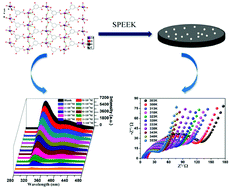Dual-functional coordination polymers with high proton conduction behaviour and good luminescence properties†
Abstract
Two coordination polymers, [M(5-hip)(H2O)3]n (M = Cd2+ (1), Zn2+ (2), 5-hip = 5-hydroxyisophthalic acid), have been synthesized under hydrothermal conditions. The crystal structure reveals that complexes 1 and 2 have 1D chain structures by the coordination of metal ions and 5-hip. 1D chains are connected by hydrogen bonds to form a 3D structure. AC impedance analysis shows that the proton conductivity of complexes 1 and 2 comes up to 1.58 × 10−3 S cm−1 (98%RH, 343 K) and 5.27 × 10−4 S cm−1 (98%RH, 353 K), respectively. To further improve the proton conductivity, a hybrid membrane was prepared by the solution casting method with complexes as fillers and sulfonated polyether ether ketone (SPEEK) as the organic matrix. The proton conductivity of hybrid membranes 1@SPEEK-5 and 2@SPEEK-5 is 1.97 and 1.58 times higher than that of pure SPEEK membranes, respectively. Furthermore, the two complexes are excellent fluorescent sensors, which could detect Cr2O72− in aqueous solution with high sensitivity and selectivity. Both of them have low detection limits for Cr2O72− in aqueous solution, where the detection limit of complex 1 is 0.8 μM and that of complex 2 is 1 μM. The above work demonstrates that the two complexes are dual-functional materials with high proton conduction and good fluorescence properties.



 Please wait while we load your content...
Please wait while we load your content...